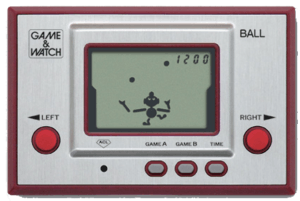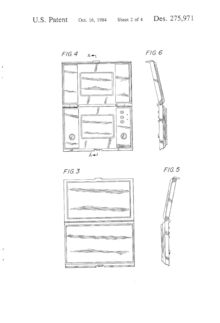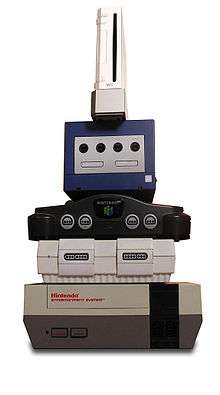Game & Watch series
The Game & Watch brand (Japanese: ゲーム&ウオッチ Gēmu & Uotchi; called Tricotronic in West Germany and Austria, abbreviated as G&W) is a series of handheld electronic games developed, manufactured, released and marketed by Nintendo from 1980 to 1991. Created by game designer Gunpei Yokoi, each Game & Watch features a single game to be played on a LCD screen as well as a clock, hence the name.[1][2] The models from 1981 onwards featured an alarm in addition.[3] It was the earliest Nintendo video game product to gain major success.[4]
 | |
 Game & Watch Ball, the first title in the series | |
| Also known as | G&W, Tricotronic (West Germany, Austria) |
|---|---|
| Developer | Nintendo R&D1 |
| Type | Series of handheld electronic games |
| Generation | Second generation |
| Release date | April 28, 1980 (Ball) |
| Lifespan | 1980-1991 |
| Discontinued | October 14, 1991 (Mario the Juggler) |
| Units sold | c. 43.4 million |
| Units shipped | Unknown |
| CPU | Sharp SM5xx family |
| Display | Liquid-crystal display |
| Power | Button cell |
| Successor | Game Boy family |
The units are based on a 4-bit CPU from the Sharp SM5xx family, that include a small ROM and RAM area and an LCD screen driver circuit,[5] although prior to the emulation in MAME there was a misconception in that every unit used a custom ASIC instead of a proper microcontroller.
The series sold a combined of 43.4 million units worldwide.[6]
Origin and design
Game designer Gunpei Yokoi, while traveling on a Shinkansen, saw a bored businessman playing with an LCD calculator by pressing the buttons. Yokoi then thought of an idea for a watch that doubled as a miniature game machine for killing time.[7]
Those units use LR4x/SR4x "button-cell" batteries, the same type used in most laser pointers or handheld calculators.
Different models were manufactured, with some having two screens and a clam-shell design (the Multi Screen Series). The Game Boy Advance SP, Nintendo DS, and Nintendo 3DS later reused this design.[8]
Titles available in Game & Watch form vary from Mickey Mouse to Balloon Fight, including Nintendo staples such as Donkey Kong, The Legend of Zelda, and Mario Bros..
The modern "cross" D-pad design was developed in 1982 by Yokoi for the Donkey Kong handheld game. The design proved to be popular for subsequent Game & Watch titles. This particular design was patented and later earned a Technology & Engineering Emmy Award.[9][10]
Game A and Game B
Most of the titles have a 'GAME A' and a 'GAME B' button. Game B is generally a faster, more difficult version of Game A, although exceptions do exist, including:
- In Squish, Game B is radically different from Game A — the player must touch aliens to eliminate them as opposed to avoiding moving walls.[11]
- In Flagman, Game B is a mode where the player has to press the right button within a certain amount of time, not memorizing patterns.
- In Judge, Boxing, Donkey Kong 3, and Donkey Kong Hockey, Game B is a two-player version of Game A.[12]
- In Climber,[13] Balloon Fight,[14] and Super Mario Bros.,[15][16] there is no Game B button.
Series

- Silver (1980)
- Gold (1981)
- Wide Screen (1981–1982)
- Multi Screen (1982–1989)
- New Wide Screen (1982–1991)
- Tabletop (1983)
- Panorama (1983–1984)
- Super Color (1984)
- Micro Vs. System (1984)
- Crystal Screen (1986)
There were 59 different Game & Watch games produced for sale and one that was only available as a contest prize, making 60 in all.[17] The prize game was given to winners of Nintendo's F-1 Grand Prix tournament, a yellow-cased version of Super Mario Bros. that came in a plastic box modeled after the Disk-kun character Nintendo used to advertise their Famicom Disk System.[16] As only 10,000 units were produced and it was never available for retail sale, the yellow version is considered rare.[17]
Mario the Juggler, released in 1991, was the last game created in the Game & Watch series.[18]
Headache, released in 1981, is the UK version of Helmet, devoid of the vulgar connotations of the word in Europe. This title is hard to find due to its region isolation and was released under CGL (UK). Headache could arguably be the rarest Game & Watch game.
Judge, released in 1980, features two different colour schemes; purple and green.
Releases
The Game & Watch games were renewed between 1995 and 2002 with the Game & Watch Gallery series, five Game & Watch collections released for the Game Boy, Game Boy Color, and Game Boy Advance. They feature the original ports, as well as new, modernized versions starring the Mario series cast.
From 1998 onward, a number of third-party distributors have been licensed to re-release smaller LCD versions of ten separate Game & Watch games which together compose the Nintendo Mini Classics series.
In 2001, Nintendo released Manhole-e bundled with its Nintendo e-Reader systems.[19] Although an entire line of Game & Watch e-Reader cards were planned, they were never released.
Between July 2006 and March 2010, Nintendo produced two Game & Watch Collection cartridges for the Nintendo DS to be released exclusively for Club Nintendo members. The first cartridge featured three games from the Game & Watch Multi Screen series: Oil Panic, Donkey Kong, and Green House. The second compilation, Game & Watch Collection 2, contained Parachute, Octopus, and a new dual-screen game with Parachute on the top screen and Octopus on the bottom. Both cartridges are now available to the general public.
Between July 2009 and April 2010 Nintendo released nine separate Game & Watch ports for DSiWare including remakes of Ball (called Game & Watch: Ball),[20] Flagman (called Game & Watch: Flagman), Manhole (called Game & Watch: Manhole),[21] and Mario's Cement Factory (called Game & Watch: Mario's Cement Factory) among others.[22][23]
In March 2010, Takara Tomy released officially licensed Game & Watch-styled keychains, based on the Wide Screen series editions of Octopus, Parachute, and Chef. They do not actually run the games, instead just display a demo screen. While the game cannot be played, the speed at which the demo runs can be adjusted. The batteries are recharged with solar panels on the unit.[24]
Ball was rereleased exclusively via Club Nintendo to celebrate the 30th anniversary of Game & Watch, with the Club Nintendo logo on the back. Unlike the original release, this version includes a mute switch.[25] For members of the Japanese Club Nintendo, after an announcement in November 2009, it was shipped in April 2010 to Platinum members.[26][27] For members of the North American Club Nintendo, it was available for 1200 coins from February 2011.[28][29] For members of the European Club Nintendo, it was available for 7500 stars from November 2011.[30][31]
Legacy
The Game & Watch made handheld video game consoles vastly popular. Many toy companies followed in the footsteps of Game & Watch, such as Tiger Electronics and their Star Wars themed games.
Nintendo's Game & Watch units were eventually superseded by the original Game Boy. Each Game & Watch was only able to play one game, due to the use of a segmented LCD display being pre-printed with an overlay. The speed and responsiveness of the games was also limited by the time it took the LCD to change state. The Nintendo Entertainment System (NES) controllers were based on the controls in Game & Watch, and Game & Watch Multi Screen version became the model on which the Nintendo DS was based.
Nintendo Game & Watch was issued under different trademarks in different countries, resulting in different packaging. These have become rare and are also collectible.
The Game & Watch Gallery series recreates the Game & Watch games in video game form, with modes that imitate the LCD displays and modes that modernise the graphics and include Mario characters. Game & Watch games have also been released through DSiWare.
Nintendo Land for the Wii U has a mini-game named Octopus Dance that's based on the Game & Watch game Octopus.
Game & Wario for the Wii U heavily references the Game & Watch line, including the ability to play a virtual Game & Watch version of Pyoro/Bird & Beans.
Mr. Game & Watch

Mr. Game & Watch is a generic amalgam of black, open-mouthed, big-nosed cartoonish stick figure silhouettes from the Game & Watch games. The Mr. Game & Watch name first appeared in Super Smash Bros. Melee.[32] The character was created as an homage to the Game & Watch series, and his moveset consists of elements from many different titles; for example, his standard attack is the bug spray from Greenhouse, and his neutral special attack uses the frying pan from Chef to launch food at his opponents. The symbol of the Game & Watch series is the character ringing a bell whilst wearing a helmet, representing the alarm feature many titles contain.
In the Game & Watch games themselves, the playable characters vary in appearance, as they often sport eyes, teeth and clothes, all of which Mr. Game & Watch lacks. However, in the Super Smash Bros. series, his trophies list his first appearance as "Game & Watch, 1980"; this makes him the oldest character in the series by game release date, with Pac-Man being the only other to have been introduced in 1980. Super Smash Bros. Ultimate also alters his appearance when he performs certain attacks to match how the characters look in the game of the attack's origin.
After his debut, Mr. Game & Watch reappeared in subsequent Super Smash Bros. titles, as well as in Game & Watch Gallery 4, wherein he is the manager of the "classic games" area alongside Mario. He also makes a cameo appearance in Donkey Kong Country Returns in the background of level 7–1, as a worker in a foggy factory. He also appears during certain stages in Rhythm Heaven Fever.
Mr. Game & Watch is never heard speaking in the Super Smash Bros. series. Instead, he emits beeping noises similar to those heard while playing the Game & Watch games, although he does have speech balloons in Game & Watch Gallery 4. His other distinct traits include being paper-thin due to having only two dimensions (although he is actually a 3D model flattened for this effect) and thus not possessing depth, which is translated to him being a lightweight character within the Super Smash Bros. series, as well as limited/choppy animations. These traits allude to the graphical limitations of the Game & Watch games.
In Super Smash Bros. Brawl, the game's story mode, The Subspace Emissary, suggests Mr. Game & Watch is made of a primordial substance that can take on any number of forms. Mr. Game & Watch was harvested for this reason to create the Subspace Army.[33] As claimed by the Smash Bros. DOJO!!, the official website for Super Smash Bros. Brawl, Mr. Game & Watch allowed this to happen because he has no concept of good and evil.[34]
Game & Watch games referenced by Mr. Game & Watch's moveset include:
- Ball - All throws
- Chef - Neutral special
- Donkey Kong Jr. - Down aerial
- Fire Attack - Forward smash
- Fire - Up special
- Flagman - Up tilt
- Green House - Neutral attack
- Helmet - Dash attack
- Judge - Side special
- Lion - Forward tilt
- Manhole - Down tilt
- Mario Bros. - Forward aerial (Melee, Brawl and for 3DS and Wii U); down taunt (for 3DS and Wii U and Ultimate)
- Mario's Bombs Away, Safebuster or Bomb Sweeper- Forward aerial (Ultimate)
- Mario's Cement Factory - Grab
- Octopus - Up smash, Final Smash
- Oil Panic - Down special
- Parachute - Neutral aerial (Melee); up special (Brawl and later)
- Spitball Sparky - Up aerial
- Tropical Fish - Neutral aerial (Brawl and later)
- Turtle Bridge - Back aerial
- Vermin - Down smash, edge attacks (Melee), all floor attacks
- Alarm feature from multiple titles - Pummel, edge attacks (Brawl and later), up and side taunts
Reception
UGO.com listed Mr. Game and Watch on their list of "The Cutest Characters", stating "Mr. Game and Watch is adorable because he's completely oblivious to his condition."[35]
See also
References
- cary (2013-05-16). "Digital game + digital clock = Game & Watch!". Recollections of Play. Retrieved 2020-06-15.
- "Game & Watch (Franchise)". Giant Bomb. Retrieved 2020-06-15.
- "Feature: The History of the Nintendo Game & Watch". Nintendo Life. 2010-02-24. Retrieved 2020-06-15.
- "Wii.com - Iwata Asks: Super Mario Bros. 25th Anniversary". Us.wii.com. Archived from the original on 2011-12-31. Retrieved 2011-03-23.
- MAME emulator source code
- "Iwata Asks: Game & Watch". Nintendo of America. Retrieved 2013-06-23.
- The Escapist: Searching for Gunpei Yokoi
- http://www.nintendolife.com/news/2010/02/feature_the_history_of_the_nintendo_game_and_watch
- "Nintendo Wins Emmy For DS And Wii Engineering | Technology | Sky News". News.sky.com. 2008-01-09. Archived from the original on 2012-07-11. Retrieved 2010-08-30.
- Magrino, Tom (2008-01-08). "CES '08: Nintendo wins second Emmy - News at GameSpot". Gamespot.com. Archived from the original on 2013-01-02. Retrieved 2010-08-30.
- "gw / squish". Retrieved 2009-07-11.
- van Spanje, Martin. "#026: Judge - a Nintendo Game & Watch collection". Retrieved 2009-07-11.
- "gw / climber". Retrieved 2009-07-11.
- "gw / balloon fight". Retrieved 2009-07-11.
- "gw / super mario bros". Retrieved 2009-07-11.
- "Nintendo Super Mario Bros Promo". Retrieved 2009-07-01.
- "Super Mario Bros. YM-901". 2009-01-02. Retrieved 2009-07-01.
- "Obscure Pixels - Nintendo Game&Watch". Archived from the original on 2018-11-30. Retrieved 2009-07-11.
- "Game & Watch Collection: Manhole Release Information for e-Reader". GameFAQs. Retrieved 2013-07-06.
- "Game & Watch: Ball Release Information for DS". GameFAQs. 2010-04-19. Retrieved 2013-07-06.
- "Game & Watch: Manhole Release Information for DS". GameFAQs. 2010-04-05. Retrieved 2013-07-06.
- "Game & Watch: Mario's Cement Factory Release Information for DS". GameFAQs. 2010-03-22. Retrieved 2013-07-06.
- "GAME&WATCH". Nintendo.co.jp. 2009-07-10. Retrieved 2009-07-11.
- "Retro Games Immortalised as Solar-Powered Miniature "Game & Watch" by Takara Tomy". Gigazine. January 18, 2010. Retrieved 2 November 2014.
- "Game & Watch". Iwata Asks. Nintendo. Retrieved 1 November 2014.
- Spencer (November 18, 2009). "Platinum Club Nintendo Members Get Game & Watch". Siliconera. Curse. Retrieved 2 November 2014.
- McWhertor, Michael (November 18, 2009). "Club Nintendo Offers Members Actual Game & Watch Prize". Kotaku. Retrieved 2 November 2014.
- Winterhalter, Ryan (February 11, 2011). "Club Nintendo offering Game & Watch replica". gamesradar. Future. Retrieved 2 November 2014.
- "Game & Watch: Ball". North American Club Nintendo. Nintendo. Retrieved 2 November 2014.
- Newton, James. "Game & Watch Gifts Added to European Club Nintendo". Nintendo Life. Retrieved 2 November 2014.
- "Game & Watch: Ball". European Club Nintendo. Nintendo Europe. Archived from the original on 2 November 2014. Retrieved 2 November 2014.
- "Super Smash Bros. Melee guide: Mr. Game & Watch". IGN. Retrieved 2008-05-15.
- Shadow Bugs - Trophy Description. Super Smash Bros. Brawl. Nintendo. 2008
- "Mysteries of The Subspace Emissary".
- Marissa Meli (March 4, 2011). "]The 50 Cutest Video Game Characters - UGO.com". UGO.com. Archived from the original on January 10, 2014. Retrieved 2011-03-21.
External links
| Wikimedia Commons has media related to Game & Watch. |
- GAME&WATCH at Nintendo official website (Japanese)
